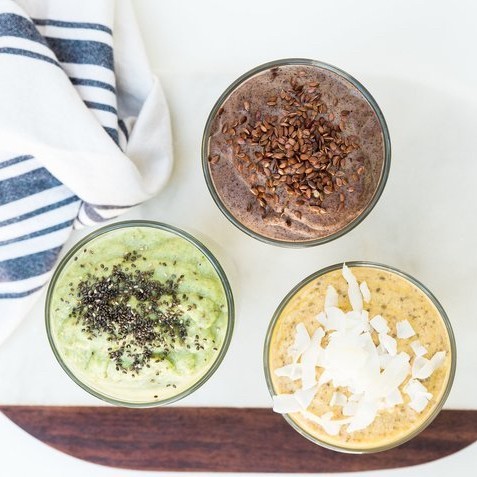Finding A Rhythm With Both Diet And Exercise Will Push You Over Your Plateau
It’s hard to underestimate the importance of routine and structure when it comes to healthy weight management. Our bodies are programmed based off the rhythm of our day, influenced by the hormonal, environmental, and behavioral routines we put into place. Your brain likes to know what’s ahead, it actually craves routine. As you get into a habit, your brain can anticipate what you’re supposed to do next, and that makes it easier to stay on track, with both your diet and exercise. Think of yourself like a newborn. It’s no different than teaching a baby a new sleep pattern. You have to create a “bedtime routine” and stay consistent with bed time, and the sleep surroundings, right? Creating healthy habits for yourself should be treated no differently.

Take for example your eating patterns. During the week, you likely eat lunch around the same time every day, say around noon. This can train your body to crave food at the same time each day, therefore making it much less likely likely to crave food during other times of the day. But if you’re not paying attention to when you’re eating, or how much over the course of 24 hours, you will quickly derail your results. All too often, we assume we’re burning more calories than we actually are. When you view exercise as a “chore” that in turn earns you a reward, this thought process makes it easier to reach for a high-calorie food “treat” later in the day. You could end up taking in more calories per day than you were getting before you even started your exercise program. Plan on sticking with a consistent caloric intake daily, regardless of your calories burned during exercise. Unless you’re training for an ultra-marathon, there’s no need to fuel your body pre-workout, or replenish your body post-workout, with added calories (*As long as you’re eating three, well-balanced meals throughout the day. More on that below!)
There is a thin line between consistency, and being overly rigid. For example, instead of saying “I must each lunch at noon every day”, focus on hitting a time in-between meals goal instead. This gives you some leverage, so if a meeting gets scheduled for noon, it’s ok, you can tweak when you have breakfast, and dinner, if needed. Try to aim for 4 – 6 hours in-between meals. This means you likely need to eliminate any snacks. You actually don’t need a snack to balance your blood sugar. In fact, it’s quite the opposite. The process of digestion and absorption is a multi-hour process for your body to break down, typically at least six hours for complete digestion. Eating every 2-3 hours sets you up for exhaustion, premature aging, and less fat burning.

Why? Because you’re restarting the process of digestion, every time you eat something, therefore constantly taxing your body. Your body has not likely broken down your breakfast, when you grab a latte or protein bar mid-morning, re-starting the digestion process. This not only takes energy away from other repairs your body is making (that can affect your energy levels and cell restoration), it cannot effectively absorb and utilize your food from your last meal, so it stores it as fat instead. You burn fat and lose weight in-between meals (and during sleep), when your blood sugar is in balance and you don’t have excess insulin in your bloodstream. The key to being able to go longer in-between meals (and no snacking!) is making sure your meals are nutrient-dense and you’re eating to satiety during your three primary meals for the day, while still maintaining portion control. We love the book “Body Love” by Kelly Leveque for more information on a diet around balanced blood sugar. Or consider contacting a local dietician or nutritionist for a custom meal plan for your body.
The same rule of consistently stands for your exercise routine. It’s fun to switch up your workout, but constantly changing up your exercise routine, and potentially your schedule, can likely lead to inconsistency, and make it difficult to maintain long-term. Pick your primary method of exercise. It should be something you consider fun, enjoy doing, and something that you can commit to at least 2 – 3 times per week. Then consider a “freebie” that you incorporate, outside of those days. Maybe it’s a workout class outside of your comfort zone that is a new challenge, or maybe it’s a long walk or hike outdoors on the weekend. But your primary exercise does not get bumped for your “freebie”, your 3 primary classes or workouts are a set, non-negotiable part of your routine, no different than brushing your teeth or taking a shower on those days. I know, I know your schedule is hectic, maybe it changes weekly, or monthly. But I promise you can find 2 -3 days, out of 7, to honor this commitment for yourself. It’s ok to change your schedule when necessary, but again rebuild your routine around consistency when you need to make a change.

Don’t think you have to completely overhaul your diet or add crazy amounts of exercise to see results. Set one small, achievable daily goal for the week, like adding one extra serving of vegetables per day (super simple to do in a smoothie!) or taking the stairs instead of the elevator, and focus on meeting those goals daily for a couple weeks, before adding in other changes. Your goal must be something measurable (i.e. eat an extra vegetable per day, versus “I want to eat healthier”). But also set the bar low for yourself, so it’s also achievable. These are considered your (daily) action goals, and ultimately lead to your end goal. Read more about our goal setting tips in our blog post here.
Quick wins do wonders for your mindset, and ultimately your success. Really focus on building yourself up and spark your inner cheerleader to help you reach these goals, and celebrate your success, along the way. Words like “discipline” can make your workouts, or diet, feel like one more chore you need to push through in order to feel happy about them being done. Consider making ‘start’ goals instead of ‘stop’ goals (“I’ll start eating a smoothie with at least one veggie for breakfast”, instead of “I’ll stop eating carbs”). Take some time to change your perspective and self-talk. Your opportunities are endless when you have a growth mindset. But our brain tends to fall in the self-doubt category, when we practice a fixed mindset, severely limiting your outcome. Mistakes, and ultimately failure, is actually gateway to growth. In order to get there, you must adjust your mindset.

Here’s an example below.
Fixed mindset – gives up: “I could never run a marathon. I am not a runner.”
Growth mindset – tries: “I think I could run a marathon. Today I will look up running groups in my area and join them for their next session.”
What will you learn from a growth mindset? Maybe you sign up for the running group, and decide a few weeks in, marathon training isn’t for you. But maybe instead you learn to run/walk at an interval pace, and therefore still achieve your goal of becoming a runner (just not a marathon runner). You have still succeeded, and will probably have found just as much joy in the journey, regardless of the end result. Consistent, actionable plans are key, and will lead you to a lifetime of healthy habits!


